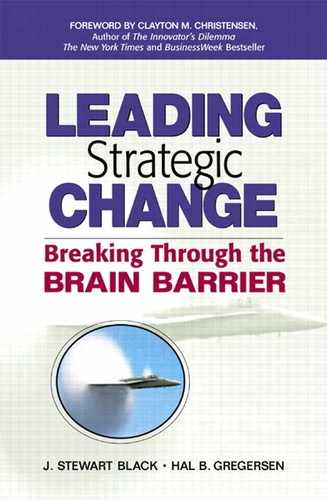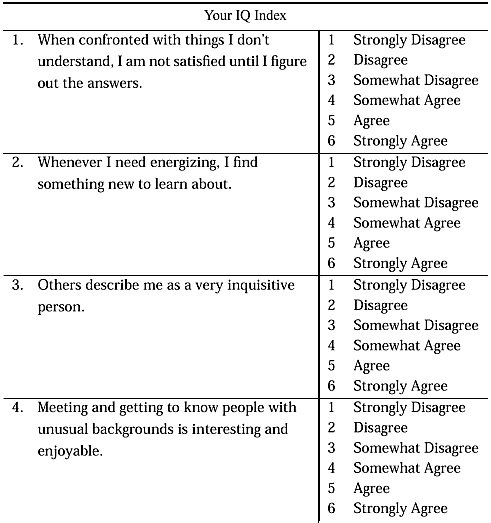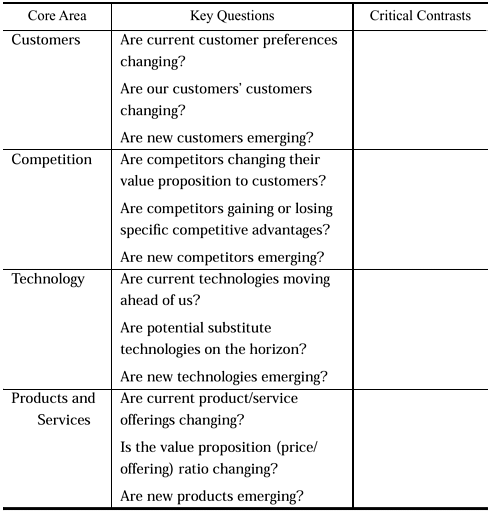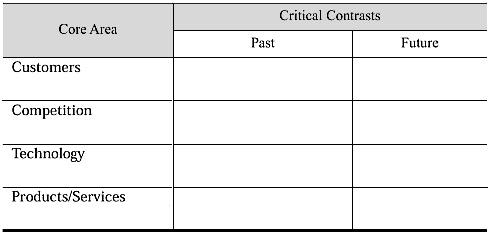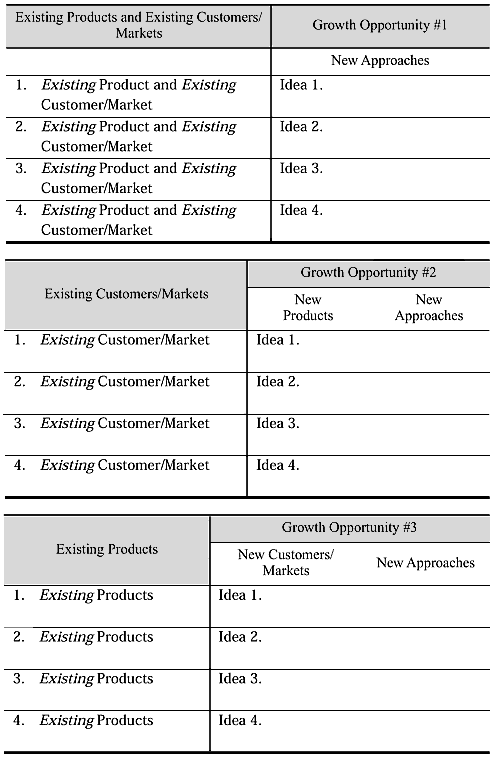Collectively, the next four chapters provide the glue to ensure that this all sticks—that it sticks together and that it sticks to you, the reader. After all, if the ideas in Leading Strategic Change do not get translated into real actions and success, they offer little lasting value. This transition from the world of principles to the world of practice is critical. The true test of this book’s value and your ultimate value to your organization hinges on what you personally put into practice.
When working with literally hundreds of managers over the past decade, we have drawn two conclusions about successfully translating principles into practice. First, most people need a set of useful tools that capture key elements of the principles. Second, leaders add the greatest value to their company by teaching others the principles and helping them put the principles into practice. Great leaders at great companies regularly engage in these high-impact actions. For example, Andy Grove, Chairman of the Board at Intel, was once asked how he found time as a senior executive to train leaders at Intel’s supervisory development programs. His instant quip was, “Where can I get more leverage in shaping the future of Intel?” Similarly, Larry Bossidy, CEO of Honeywell and past protégé of Jack Welch at GE, contends, “When you retire, you won’t remember what you did in the first quarter of last year, or the third. You’ll remember how many people you developed—how many you helped have a better career because of your interest and dedication to their development. When you’re confused about how you’re doing as a leader, find out how the people you lead are doing. You’ll know the answer.” For Grove and Bossidy, and any other CEO worth his or her pay, providing the right tools and teaching others how to use them play central roles in leading change.
Building on these two key leadership observations, these next three chapters walk through the complete set of Leading Strategic Change principles and provides proven tools that, if used, can help you successfully break through brain barriers in your organization. These tools also provide excellent “teaching and practice aids.” In other words, we have found these tools helpful in conveying change principles to others (subordinates, peers, and even superiors) and enhancing their ability to put the principles into practice. The final chapter applies the principles to the most challenging change—anticipatory change.
Although these next three chapters focus on the change toolkit, we all recognize that credibility with others demands that you practice what you preach. Leading by example has endured as one of the most effective leadership principles since time began. If you want others to change, you need to demonstrate your own willingness and ability to change. However, just because you lead does not guarantee that others will follow. This is why we already stated (but it’s worth repeating) that the most effective value-adding leaders teach others what they know and how to do it.
We have presented this fundamental principle at the outset of the book, but here it is one last time: Organizational change begins by changing individuals—not the other way around. Even the most ardent believers in organizational change have agreed with us that, at a minimum, organizational change requires some individual “early adopters.” Just as in the marketplace, a new product almost never hits immediately. It takes early adopters to get “traction” or momentum. Organizations are the same. If a few individuals in the organization do not adopt the initiative and change their behavior, pulling all the “organizational” levers in the world will produce nothing but sore arms. Like a car, you can change the engine or suspension design but those changes matter only when the rubber hits the road. The changes can look great on paper, but unless the engine redesign gives you greater acceleration or the suspension modification gives you better handling, neither makes a practical difference. Likewise, you can design new corporate strategies, structures, information systems, or shared values, but their impact can materialize only when individuals do something different than before. If changes look great on paper but don’t get translated into different behaviors, the changes will not deliver lasting value to shareholders, customers, or employees.
As overwhelming as changing 100,000 or 100 people might seem, in the end, that is what must happen. Consequently, effective change champions must exist throughout the organization. As researchers and consultants, we have rarely seen a ratio greater than one change leader to 100 individuals result in significant, lasting strategic change. This track record emphasizes the need to empower other change champions through example and personal instruction.
By the way, we know that many organizations refer to teaching others using terms or phrases such as knowledge transfer. We also know that most everyone but professors hate the notion of “teaching” or “instructing” others. However, whether in a book, article, speech, or consulting engagement, we deliberately use teach or instruct instead of knowledge transfer” or manage. We find these less popular words more valuable for change because terms such as knowledge transfer often invoke a passive, mechanistic map in people’s minds. Transferring knowledge quickly and effectively does not happen by osmosis. To get as many people as possible rapidly capable of strategic change, you must take an active, direct role in teaching them the new principles, as well as coaching them in their application and implementation efforts.
With that introductory framework to this and the other remaining chapters, we now focus on reviewing the principles and discussing the most effective tools around for helping people apply the principles. The three “toolkit” chapters are organized around on our three-part approach to remapping change—CBA (conceiving, believing, achieving).
If people don’t see the need to change, they will not change— unless compelled. Although beating people into submission is possible, it is expensive and results in open rebellions or at the least a quiet return to old habits as soon as the beating stops. Consequently, the most prevalent reason for failed change is the first brain barrier—the failure to see.
As discussed in the beginning of this book, we see the need for change only when a contrast is clear. Like a truck far off in the distance, distant opportunities and threats are very hard to see. It is not until the truck blares its horn and nearly smacks into us (or, for some of us, it actually takes getting run over) that we finally notice our well-worn map that had guided us down quiet neighborhood streets is no longer valid. It usually takes this sort of dramatic, “high-impact” event for us to recognize that the world has changed and we are no longer on a quiet country road but, instead, standing in the middle of a busy expressway.
As common as this process is, there are exceptions. Some people consistently see the truck coming long before it blares its horn, but they are rare (at least in our research). Equally rare is that moment when the rest of us actually see the threat or opportunity long before it became incontrovertible. In either case (consistent see-ers and infrequent sight-ers), we found a common factor. These people sought out contrast. They actively ques-tioned their current map. So why, if the current map was working well, did they go out looking for contrast? The common force behind the quest was inquisitiveness.
We say “inquisitiveness” because what we observed in these people was stronger than curiosity and more pragmatic than loving to learn. Inquisitive people and those who experienced a temporary inquisitive spike simultaneously followed their current maps, yet actively questioned their validity. By questioning their mental maps, they purposefully sought out evidence, signs, and signals that contrasted or even contradicted their current maps.
We have found it interesting that without the fuel of inquisitiveness (iQ), actively looking for contrasts such as alternative business models, sales approaches, marketing messages, management styles, or technologies is very exhausting. For low-iQ leaders, searching for new solutions is as attractive as starting a transoceanic flight with only a few gallons of gas in the plane’s tank. With only a few gallons in the tank, low-iQ leaders view taking the flight as a significant drain on precious resources, and consequently, they opt to stay on the ground. After all, why fix what isn’t broken?
However, high-iQ leaders draw energy from the opportunity to hear new ideas, see new models, visit new markets, etc. They look forward to opportunities to examine issues from new and different perspectives. It gets them up in the morning.
We could go on, but most need little convincing that a high dose of inquisitiveness enhances a person’s willingness and ability to change. However, there is a more pragmatic concern. As one manager put it, “Fine, I get it. The more inquisitive your nature, the easier it is for you to recognize and make changes. But can you do anything about the natural level of your inquisitiveness or, for that matter, anyone else’s?”
The answer based on research is moderately encouraging. Yes, you can enhance the level of inquisitiveness in you or others, but not infinitely. Research suggests that much of our “natural” inquisitiveness is set by genetics and early childhood experiences (though it seems impossible to disentangle the two and say with precision which, nature or nurture, is more responsible). The questionnaire in Exhibit 9-1 provides a very general sense of your (or others’) natural iQ level.
Scoring your survey is relatively simple. Add up the circled numbers for Questions 1–10. The highest possible score is 60. Your total iQ score was ______. Now check to see where your score fits in the following inquisitiveness ratings.
60–50 World-class iQ leaders
49–35 Strong iQ leaders
34–20 Average iQ leaders
19–less Weak iQ leaders
An alternative to the questionnaire above is simply testing yourself or others against the following true story from a high-iQ leader’s life and judging what your reaction would be in the same situation. J. Bonner Ritchie reflects world-class inquisitiveness. We have seen it shine in his consulting, teaching, and personal life. For example, several years ago, Bonner was driving with his wife and children on a German autobahn. As he sped down the road, he suddenly realized that he was headed away from his intended destination. Those familiar with the autobahn in Germany know that it can be many kilometers between exits and “on ramps.” Rather than wait 15–20 minutes until the next exit, then reenter the highway in the opposite (correct) direction, Bonner considered a shorter route. What looked like a level, grass median separated the lanes of traffic. Bonner thought that if he looked carefully and waited for a break in oncoming traffic, he could cross the grass median and head back in the right direction. Essentially, he was going to make what is commonly called a “U Turn” in the United States. After looking carefully both ways, he pulled onto the left shoulder near a median strip of grass separating the highways. With everything clear, he drove onto the grass to go over to the other side of the highway. Suddenly, the Volvo he was driving rolled over, leaving Bonner and his family suspended upside down in a hidden gully. (The gully was hidden because a long-bladed mowing machine had cut the grass completely level between each side of the freeway.)
Imagine yourself stuck in this situation. There you are, suddenly upside down; you and your family hanging suspended by seat-belts. What are the first words that come out of your mouth? When we question executives about this in person, many use expletives that we won’t repeat.
As his family dangled, Bonner’s first words were not expletives or even inquiries about whether everyone was okay or hurt. Instead, his first words to family members were: “This is interesting. What can we learn from this?” Regardless of your score on the iQ survey in this chapter, if your first instinct in this type of situation is to learn, you top out the inquisitive scale, as Bonner does. He lives to learn and he learns to live. His enduring attitude of almost boundless inquiry mirrors what we see over and over in our work with effective change leaders.
The iQ survey and Bonner’s high-iQ leadership provide two means for gauging your (or others’) level of inquisitiveness, but we must still ask the pragmatic question of how to increase iQ. First, how can you enhance inquisitiveness in yourself? Second, how can you enhance the iQ of others?
Our suggestion for ratcheting up the iQ factor in yourself and others is to reconfigure the whos, wheres, whats, whens, and hows in your life. First, consider your everyday patterns and the whos in your world. Who do you exercise with? Who do you ride to work with? Who do you take breaks with? Who do you eat lunch with? Who do you socialize with after work? Now consider your wheres. Where do you take walks? Where do you eat lunch? Where do you vacation? Where is the desk in your office? Next, look at the whats. What do you read? What do you watch? What do you hear? What do you eat? What do you play? What do you wear? Don’t forget the whens. When do you wake up? When do you devour pizza? When do you drive home from work? When do you take long, hot baths? When do you reflect? How about your hows? How do you brush your teeth? How do you fix your breakfast? How do you get to work? How do you make a sell? How do you rejuvenate?
At this point, you might be asking yourself why you should care about the whos, wheres, whats, whens, and hows of my life. Put simply, Low-iQ leaders are creatures of habit; high-iQ leaders are masters of innovation. If we want to boost our inquisitiveness, or others’ for that matter, we must reconfigure personal routines. During interviews around the world with several hundred high-iQ leaders, we quickly discovered that living without ruts sharp-ened their inquisitiveness. For example, one high-iQ leader skilled in financial analysis lunched at least once a week with people either outside of the finance group or outside the company (new whos). Another high-iQ leader challenged himself to eating lunch at a different restaurant every day of the week for three straight months—no small feat while living in a city popu-lated by fewer than 300,000 people (new wheres). Frequently, high-iQ leaders learned new skills at work or launched new hob-bies at home; others experimented with new foods when traveling in foreign countries; and one executive actually snacked on dried dog food instead of potato chips to win a new client’s business in the pet food industry (new whats). Some high-iQ leaders changed their whens by taking Wednesdays off instead of Satur-days or by meeting with customers in the morning instead of the afternoon to catch a glimpse of different work flows. Finally, high-iQ leaders challenged their hows by substituting new approaches to old activities, such as delivering a message in person instead of simply zipping off e-mails.
These examples of new whos, wheres, whats, whens, and hows might seem trivial and at times bizarre, but regularly and consciously upsetting personal routines engages us (and those around us) in everyday learning. And transforming everyday situations into learning opportunities everyday is the fuel for greater inquisitiveness in ourselves and others.
Kenneth Chenault, CEO of American Express, recently declared, “The role of a leader is to define reality.” We concur. Regardless of whether inquisitiveness is high or low, if you recognize the need for change, the real challenge then becomes how to create enough contrast and confrontation so that others see the need. As discussed earlier, one key to effective contrast is simplification combined with a focus on the 20/80 principle first discussed in Chapter 1. Although some people can do both in one step, we have found a set of tools for a two-step process more effective with a wider variety of people. The first step is designed to bring into sharper focus what has changed—what the contrasts are. The tool (Exhibit 9-2) is a simple set of questions that uncover common core areas of essential contrast.
Clearly, the questions raised above are not the only relevant ones, but our experience is that if people take the time to answer these questions, it nudges their minds enough out of the trap of current mental maps to begin exploring new alternatives. Once people alter the mental terrain, various contrasts begin to emerge. In fact, typically once the process starts rolling, lots of contrasts become more visible. At this point in remapping change, the objective is to generate as many potential contrasts as possible for each core area listed in the tool (Exhibit 9-2) or other areas you see as important to your business that we have not mentioned.
The next step and task is boiling these contrasts down to the critical few factors—the 20% that paints 80% of the contrast picture. Once you have selected these, you can create a simple matrix (Exhibit 9-3) that will help others clearly see the most important contrasts (just like you did as the CEO of QuadQ, earlier in the book).
If generating growth is the key driver for change, we can now return to the 3D Growth Cube presented in Chapter 8 as a means of creating a useful tool to highlight and enhance contrasts between past and future growth.
When working with clients, we focus on the shaded cells in the 3D Growth Cube—the areas delivering powerful breakthrough growth (Exhibit 9-4). We do not want to create the impression that there is little opportunity for growth with the existing products, existing customers/markets, and existing approaches cell. Still, our experience causes us to wonder why smart people (including most of your competitors and possibly your firm) continue to try to squeeze the most juice out of this “existing-exist-ing” cell.
As a practical matter, even when we emphasize the shaded cells, we don’t ask people to fill in their prime targets for growth directly on the 3D Growth Cube. For many, writing on the cube can be a bit confusing, so we simply break the cube down, using the next set of tools (Exhibit 9-5). These tools are not doing anything wonderful or magical, but they do help us keep our discussion of growth opportunities a bit more organized.
Finally, even if all these tools are utilized and generate insightful contrasts, we warn against stopping here. We have seen, studied, and worked with many leaders who, upon generating what they believed were critical and compelling contrasts, then tried to move forward, only to get knocked back by the unwillingness of others to readily accept the contrasts. Keep in mind Hal’s bat-tered and bleeding head when he hit the door jams in Japan again and again. We almost entitled this book “Head-Cracking Change” because of how important inescapable experiences are in changing people’s mental maps. But the editor felt that “Head-Cracking Change” might have been a bit too graphic. Still, the point remains. We are all like Hal; it takes more than an intellec-tual confrontation with the contrast to shake loose deeply entrenched mental maps.
Consequently, you can find a simple tool for breaking through the brain barrier in Exhibit 9-6. We designed it for those leading the change. Its objective is to help you construct inescapable experiences for each critical contrast that you have worked so hard to identify. Again, from experience, it seems most effective to examine potential confrontations by category. In other words, we ask people to generate ideas on how to inescapably confront each area of contrast.
You can gain two primary benefits from taking this sequential approach to creating contrasts. First, even when you do a good job zeroing in on critical contrasts, you can often end up with too many to tackle all at once. Second, by examining potential confrontations in sequence, we find it easier to spot possible combinations.
For example, if we return to QuadQ, you may remember the idea of bringing in one of the new end users (a technician with an associates degree—not a PhD, sporting purple hair—not a lab coat) to try out QuadQ’s old technology. Compared with old end users of your products, this new technician’s obvious fumbling with your unfriendly user interface creates an inescapable experience that highlights critical contrasts relative to both customers and technology.
From our experience, trying to identify from the outset high-impact “two-for-one” or “three-for-one” experiences where you can confront two or more critical contrasts through one experience is very hard to do. Although it may seem somewhat tedious, you should find greater success if you explore potential high-confrontation experiences in sequence, rather than all at once.
After working through the tools for identifying and highlighting critical contrasts and generating high-confrontation experiences, you are in a great position to help people really see the need for change in your organization. Once they see the need (or alternatively, conceive a new map), you have thrust—the power to take off—but still need the next key, lift, for people to actually believe they can travel to the new destination.
